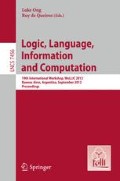Abstract
We show how to use duality theory to construct minimized versions of a wide class of automata. We work out three cases in detail: (a variant of) ordinary automata, weighted automata and probabilistic automata. The basic idea is that instead of constructing a maximal quotient we go to the dual and look for a minimal subalgebra and then return to the original category. Duality ensures that the minimal subobject becomes the maximally quotiented object.
Access this chapter
Tax calculation will be finalised at checkout
Purchases are for personal use only
Preview
Unable to display preview. Download preview PDF.
References
Adámek, J., Bonchi, F., Hülsbusch, M., König, B., Milius, S., Silva, A.: A Coalgebraic Perspective on Minimization and Determinization. In: Birkedal, L. (ed.) FOSSACS 2012. LNCS, vol. 7213, pp. 58–73. Springer, Heidelberg (2012)
Adamek, J., Herrlich, H., Strecker, G.E.: Abstract and Concrete Categories: The Joy of Cats. Dover (1990)
Arbib, M., Manes, E.: Adjoint machines, state behavior machines and duality. J. Pure Appl. Algebra 6, 313–343 (1975)
Beimel, A., Bergadano, F., Bshouty, N.H., Kushelevitz, E., Varricchio, S.: Learning functions represented as multiplicity automata. Journal of the ACM 47(5), 506–530 (2000)
Bonchi, F., Bonsangue, M., Boreale, M., Rutten, J., Silva, A.: A coalgebraic perspective on linear weighted automata. Information and Computation 211, 77–105 (2012)
Bonchi, F., Bonsangue, M.M., Rutten, J.J.M.M., Silva, A.: Brzozowski’s Algorithm (Co)Algebraically. In: Constable, R.L., Silva, A. (eds.) Logic and Program Semantics, Kozen Festschrift. LNCS, vol. 7230, pp. 12–23. Springer, Heidelberg (2012)
Brzozowski, J.A.: Canonical regular expressions and minimal state graphs for definite events. In: Fox, J. (ed.) Proceedings of the Symposium on Mathematical Theory of Automata. MRI Symposia Series, vol. 12, pp. 529–561. Polytechnic Press of the Polytechnic Institute of Brooklyn (April 1962); book appeared in 1963
Givant, S., Halmos, P.: Introduction to Boolean Algebras. Undergraduate Texts in Mathematics. Springer (2009)
Hundt, C., Panangaden, P., Pineau, J., Precup, D.: Representing systems with hidden state. In: The Twenty-First National Conference on Artificial Intelligence, AAAI (2006)
Johnstone, P.: Stone Spaces. Cambridge Studies in Advanced Mathematics, vol. 3. Cambridge University Press (1982)
Kaelbling, L.P., Littman, M.L., Cassandra, A.R.: Planning and acting in partially observable stochastic domains. Artificial Intelligence 101 (1998)
Kiefer, S.: Minimization of weighted automata (2011) (unpublished private communication)
Mislove, M., Ouaknine, J., Pavlovic, D., Worrell, J.B.: Duality for Labelled Markov Processes. In: Walukiewicz, I. (ed.) FOSSACS 2004. LNCS, vol. 2987, pp. 393–407. Springer, Heidelberg (2004)
Negrepontis, J.W.: Duality in analysis from the point of view of triples. Journal of Algebra 19, 228–253 (1971)
Panangaden, P.: Labelled Markov Processes. Imperial College Press (2009)
Smallwood, R.D., Sondik, E.J.: The optimal control of partially observable Markov decision processes over a finite horizon. Operations Research 21(5), 1071–1088 (1973)
Sondik, E.J.: The optimal control of partially observable Markov processes. Ph.D. thesis, Stanford University (1971)
Stone, M.H.: A general theory of spectra I. Proc. Nat. Acad. Sci. USA 26, 280–283 (1940)
Stone, M.H.: A general theory of spectra II. Proc. Nat. Acad. Sci. USA 27, 83–87 (1941)
Author information
Authors and Affiliations
Editor information
Editors and Affiliations
Rights and permissions
Copyright information
© 2012 Springer-Verlag Berlin Heidelberg
About this paper
Cite this paper
Bezhanishvili, N., Kupke, C., Panangaden, P. (2012). Minimization via Duality. In: Ong, L., de Queiroz, R. (eds) Logic, Language, Information and Computation. WoLLIC 2012. Lecture Notes in Computer Science, vol 7456. Springer, Berlin, Heidelberg. https://doi.org/10.1007/978-3-642-32621-9_14
Download citation
DOI: https://doi.org/10.1007/978-3-642-32621-9_14
Publisher Name: Springer, Berlin, Heidelberg
Print ISBN: 978-3-642-32620-2
Online ISBN: 978-3-642-32621-9
eBook Packages: Computer ScienceComputer Science (R0)

